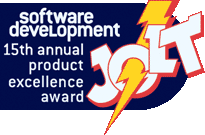Software Development
WEB DEVELOPMENT TOOLS


David Wadhwani, VP, Engineering
|
Macromedia Flex 1.5
Macromedia
Although impressive and fully functional implementations of DHTML-based user interfaces such as Google Maps are becoming increasingly common, Web developers often feel like the whole JavaScript/CSS model of Web user interfaces is being pushed to its limits to make sure that everything works in every browser. For a time, Java applets were the answer. Performance problems, overly protective security patches and differences in the way controls are rendered squashed that idea. But wouldn't it be nice to start over and design a truly platform-independent model for Web UIs—and while you're at it, how about integrating it with an application server?
This is just what Macromedia's done with its new Flex presentation server. Macromedia Flex is a server component that uses XML code to generate Flash swf user interfaces. Flex contains an extensive library of components, including visual user interface components, data models and remote service controls. The only software required on the client side is a browser with the Flash player installed.
Macromedia is probably the only company with the goodwill and installed base to attempt such a bold reinvention of the Web application. The only thing keeping Flex from exploding from a niche server into a new standard is its steep price. At $12,000 for a two-CPU license, its market penetration is likely to remain limited. Flex's demonstration of the Web's potential, however, is absolutely Jolting.
—Chris Minnick
Productivity
Award Winners |
|
Contribute 3.0 Anyone who's built a website knows that initial construction is only the beginning; a never-ending stream of changes to the content, as well as occasional changes to the architecture or design, are de rigueur. Every developer eventually looks for ways to offload content changes to the site owner, and the lucky ones find Macromedia's Contribute.
Macromedia has used the strengths of Dreamweaver's underlying engine to create, in Contribute, a tool that allows developers to put site owners in charge of their sites' content. Word, Excel and PowerPoint documents can be embedded into Contribute's pages. User-specific roles can be assigned to prevent problems, and basic site-building capabilities are included, allowing greater control over their sites. Contribute lets developers and users alike focus on what they each do best.
—Warren Keuffel |
|
NitroX 2.0 Is it a fertilizer? Rocket fuel? A gas mixture for survival respiration in far climes? For developers using JSP, Java and Struts in Eclipse, NitroX from Cupertino, Calif.–based M7 is all of the above—and then some.
I especially liked NitroX's thorough integration with Struts and the tool's holistic approach of changing a site rather than just manipulating code files. For example, setting and then triggering a breakpoint in a JSP page lets you drill stepwise down to your custom tags' affected Java code. Any changes you make to upward- and downward-affected code layers are quickly found and accomplished.
Code completion irrespective of language layer, assistance in choosing the right Struts resource for any given context, immediate detection of misnamed resources and multiplatform operation round out this strong time- and effort-saving tool.
—Roland Racko |
|
Apache Tomcat 5.0 Tomcat is a no-brainer for me—it's the industry's most popular Java Servlet and Java Server Pages (JSP) Web container, and has become the official reference implementation and standard for developing and deploying J2EE Web applications and Web services.
Its improved performance over Tomcat 4.1 comes from extensive tuning of its request pipeline, which significantly reduces memory pressure on the JVM's garbage collector, tag pooling and plug-ins, and a build system based on Ant 1.6. Tomcat is interoperable with most operating systems that are capable of running a Java Virtual Machine (JVM), including Windows, Unix, Linux and others. Tomcat's also interoperable with any JDBC-compliant database, including Oracle, SQL Server, DB2 and others.
What does all this mean? It's now easier than ever to build and deploy apps on Tomcat.
—John Lam |






